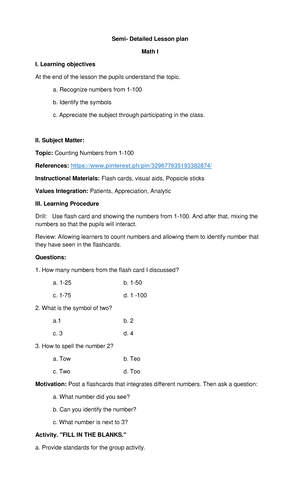- Information
- AI Chat
Was this document helpful?
Formation and Different types of Volcanoes
Course: BS Secondary Education (DRRR 01)
999+ Documents
Students shared 3575 documents in this course
University: Cotabato State University
Was this document helpful?

Republic of the Philippines
COLEGIO SAN JOSE DE ALAMINOS, INC.
COLLEGE DEPARTMENT
COLLEGE OF ARTS AND SCIENCES
Alaminos City, Pangasinan, Philippines
A.Y. 2022-2023
Detailed Lesson Plan
In Grade 9 Science
Time Frame: 60 minutes
BSED IV- General Science
I. Objectives
At the end of the lesson, the students should be able to:
1. Describe the formation of a volcano
2. Differentiate the different types of volcanoes based on their physical
characteristics and eruption styles
3. Appreciate the importance of studying volcanoes in understanding natural
hazards and geologic processes
II. Content Standard
The learners demonstrate understanding of Volcanoes found in the Philippines.
III. Performance Standard
The learners should be able to participate in activities that reduce risks and lessen
effects of climate change.
IV. Learning Competencies
1. Describe how volcanoes are formed (DS-ESE-9.1)
2. Differentiate the different types of volcanoes based on their physical
characteristics and eruption style (DS-ESE-9.2)
3. Explain the importance of studying volcanoes in understanding natural
hazards and geologic processes (DS-ESE-9.3)
V. Subject Matter
Topic: “Introduction to Volcano and Their Types”
References: Grade 9 Science Links Textbook page 206-211 and, Internet
Materials: PPT, Handouts, Recitation Pass, TV, USB, Boards and Chalk.
VI. Procedures
Teacher’s Activity Student’s Activity
A. Preliminary Activities
1. Prayer
Good morning, Class! Peace and all
Good!
Everybody stands up! Prayer leader
please.
2. Checking of Attendance
Okay class, before take your seats, kindly
pick up those pieces of trash and arrange
your chair properly.
Good morning, Sir, Peace and all Good.
Classmates, are you ready to pray?
(In the name of the Father……)
(Students will prepare their seats and surrounding
for a more conducive learning atmosphere)







